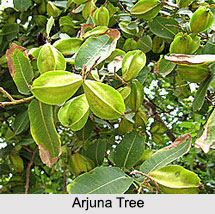 Belonging to the genus Terminalia of the family Combretaceae, the Arjuna tree is native to Indian soil and is seen all around the sub-Himalayan tracts, the Deccan regions, Myanmar and Sri Lanka. The Arjuna tree grows predominantly beside water channels or marshy belts.
Belonging to the genus Terminalia of the family Combretaceae, the Arjuna tree is native to Indian soil and is seen all around the sub-Himalayan tracts, the Deccan regions, Myanmar and Sri Lanka. The Arjuna tree grows predominantly beside water channels or marshy belts.
History of Arjuna Tree
This tree has been named Nadisarjja in early Sanskrit dissertations, where its bark has been delineated as a cardiac tonic. Vagbhatta, a distinguished physician of historic India, was the first to recommend the bark of the Arjuna tree for heart disorders. Later, Chakradatta, another celebrated Indian physician, delineated it as a tonic and an astringent and also used it in heart syndromes. He prescribed its use both as a decoction with milk and treacle water or syrup and as a ghrita, which is a preparation with ghee or clarified butter.
Description of Arjuna Tree
The Arjuna tree is a large sized deciduous tree with a height reaching up to 60 to 85 feet. It is an evergreen tree with yellow flowers and conical leaves. The Arjuna tree has a smooth grey bark which has various medicinal uses. The fruit of the tree is 2.5 -3.5 cm long, fibrous woody, glabrous with five hard wings, and striated with numerous curved veins. It has a buttressed trunk and a vast spreading crown from which the branches drop downwards. Its leaves are a combination of dull green and pale brown. The flowers of the Arjuna tree blossoms between the months of March to June and bears fruits between the months of September and November.
Importance of Arjuna Tree
Arjuna tree with all-pervasive powers cures and heals bruises, skin troubles and even acts as stimuli. The bark of Arjuna tree provides cardiac stimulus and has cooling and strengthening effects. It is constructive in holding back secretion or haemorrhage. It helps in mitigating feverish symptoms. Arjuna is also helpful in removing calculi or stones formed inside the urinary system, in encouraging flow of bile and in the convalescence of wounds.
The bark and preparations made from the Arjuna tree are believed to have a remarkable stimulating effect on the heart. The practitioners of Indian system of medicine use them in conditions of cardiac arrest and dropsy. Some practitioners of modern medicine believe in its stimulating action upon the heart and use it as a cardiac invigorator. As a cardiac stimulant, either a decoction of the bulky portion of the bark mixed with milk should be consumed every morning in an empty stomach or its powder- in 0.75 to 2 grams doses, should be used with milk and jaggery.
Ayurvedic Uses: The bark of the Arjuna tree is regarded helpful in the treatment of asthma. According to this system, a fine powder of the bark is prepared and preserved in a well-corked bottle. A patient suffering from asthma should fast on the day of full moon. A dish of condensed milk and rice or kheer should be cooked and placed under moonlight the whole night. During the wee hours of morning, 12 grams of the powdered bark should be dispersed over the kheer and taken by the patient to his satiation. The patient must not go to sleep for at least 12 hours after intake. This is known to provide comfort.
The bark of Arjuna tree also helps the bones to retrieve their potency after a fracture. The powder of the bark can also be had with honey. A decoction of the bark taken in doses of 15 to 30 grams may alleviate patients of diarrhoea or dysentery. An ointment prepared by blending the bark and honey applied over the sore area, can heal acne fruitfully.
The juice of fresh leaves of Arjuna tree can be used helpfully in earache. Ashes of the bark are also recommended in scorpion stings. The decoction of the herb is used as an astringent for cleansing sores, ulcers and syphilitic infections.
The bark of the Arjuna tree contains extraordinarily huge quantities of calcium, modest amounts of aluminium and magnesium and tannins -an astringent used in developing leather and manufacturing ink. It also possesses a crystalline compound arjunine, as well as lactone, arjunetin, volatile oil, sugars and colouring stuff. It is said that Arjuna is one of those species whose leaves are fed on by the Antheraea paphia moth which produces the tussar silk, which is of great commercial importance.











